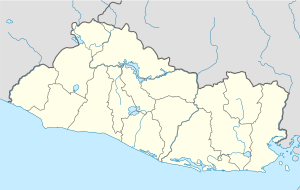Cara Sucia (El Salvador)
| Cara Sucia | ||
|---|---|---|
|
Coordinates: 13 ° 47 ' N , 90 ° 2' W Cara Sucia on the map of El Salvador
|
||
| Basic data | ||
| Country | El Salvador | |
| Department | Ahuachapán | |
| City foundation | 2nd century BC Chr. | |
| Detailed data | ||
| height | 41 m | |
| Waters | Río Cara Sucia | |
| Time zone | UTC −6 | |
Cara Sucia is a pre-Columbian archaeological site in the Ahuachapán department in El Salvador . Most researchers assign it to the Cotzumalhuapa culture . The highlands northeast of Cara Sucia, called El Imposible , are the most extensive contiguous wooded area of El Salvador with around 3000 hectares and were declared a national park ( Parque National ) in 1989 .
location
Cara Sucia lies at a height of approx. 40 m above sea level. d. M. in the Municipio de San Francisco Menéndez in the Cantón Cara Sucia, on the grounds of the Hacienda Cara Sucia . The site is approximately 115 km west of the state capital, San Salvador ; the Pacific coast is about 15 km south.
Research history
The archaeological site of Cara Sucia was discovered during clearing work. Cara Sucia was first mentioned in the literature by Santiago Ignacio Barbarena (1851-1916) in the late 19th century when he reported on the Disco del Jaguar , a stone disc, found there .
There have been archaeological excavations here since 1976. The extent of the site is estimated to be 20 hectares. 2 of the 24 hills are explored. Building complex I, from 900 AD, is called Upper Town, and building complex II was a ball playground . Although Cara Suica is one of the most important archaeological sites in West El Salvador, it currently offers little visual appeal for visitors. The place is made up of grassy hills, some of impressive proportions. A path leads past some of the higher hills.
history
According to previous knowledge, Cara Sucia was founded in the 2nd century BC. BC - that is, still in the pre-classical period - and is therefore one of the earliest records of agricultural settlements in southern Mesoamerica . The site was likely culturally influenced by the area of Cotzumalhuapa in southern Guatemala in the late classical period . This can be seen in the sculptures, architecture and ceramics discovered so far. The place was abandoned around 900; it seems that the immigration of the Nahuatl -speaking Pipilen had something to do with the abandonment of the site.
Sculptures
In 1976 Stanley H. Boggs published an article on sculptures from this location. Paul Amaroli is currently conducting studies in Cara Sucia and interprets the finding of artifacts from Cotzumalhuapa as traces of a temporary rule of this region over Cara Sucia.
- Sculpture No. 1: Disco del Jaguar : disc diameter 85 cm; Width 30 cm, relief representation, jaguar head on one side, people fighting opposite. It is located in the Museo Nacional de Antropología, Dr. David J. Guzman.
- Sculpture No. 2: Stele height: 1.60 m; Width: 0.60 m, four-sided depicting the skin of a snake. In the upper section a jaguar is shown fighting a snake. The stele is connected to the base plate with a cylindrical nail.
- Sculpture No. 3: Stele height: 1.88 m; Width: 0.45 m with a representation of a person, above a skull
- Sculpture No. 4: Stele height: 0.63 m; Width: 0.50 m, in which the body of a snake was engraved.
Individual evidence
- ↑ Phyllis Mauch Messenger, The ethics of collecting cultural property: whose culture? whose property? , UNM Press, 1999, 301 pages, page 135
- ↑ Joyce Kelly, An archaeological guide to northern Central America: Belize, Guatemala, Honduras, and El Salvador , University of Oklahoma Press, 1996, 324 pages
- ↑ El Diario de Hoy , 7 de mayo de 2006, Viaje al pasado de Cara Sucia
- ^ El Diario de Hoy , 27 de febrero de 2005, La difícil comprendsión del disco de Cara Sucia
- ↑ skyscrapercity.com, Museo Nacional de Antropología
